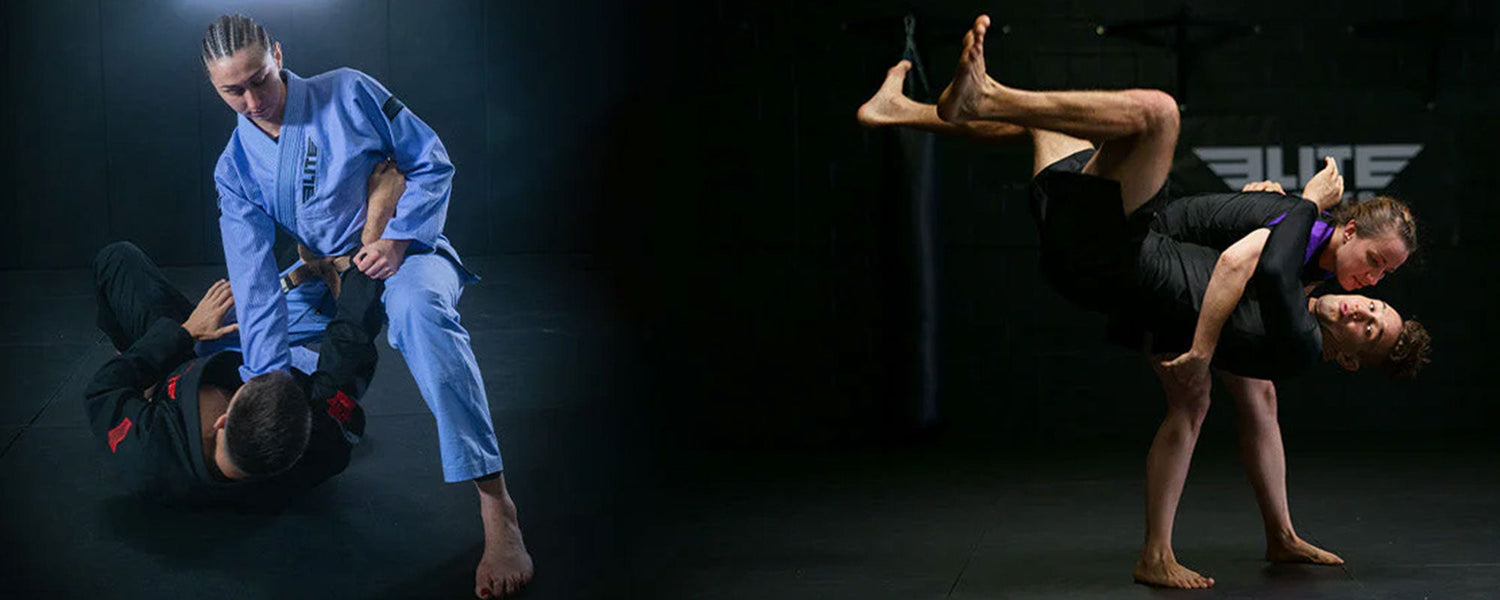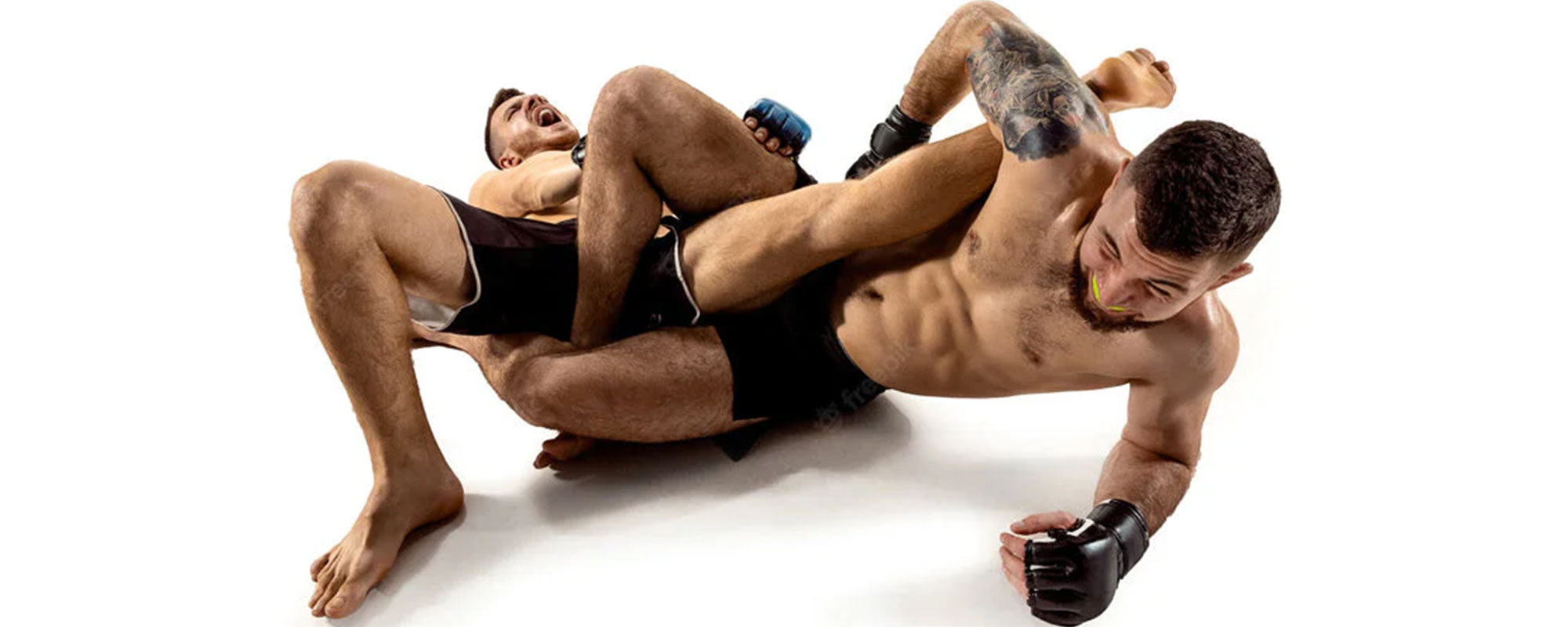Table of content
Brazilian Jiu-Jitsu is one of the most well-known martial art forms in the world.
It is likely because it focuses less on physical prowess than traditional martial arts like Muay Tai or judo. Jiu-jitsu focuses on leveraging your opponent's power against them instead of punching out or assaulting your opponent.
Originating in feudal Japan, jiu-jitsu eventually was introduced to Brazil in the mid-1990s, where it evolved into Brazilian Jiu-Jitsu (BJJ). The Gracie family was instrumental in introducing jiu-jitsu to the masses and spreading its popularity.
Through the years, Brazilian Jiu-Jitsu has split between two types of grappling: Gi and No-Gi BJJ. Brazilian Jiu-Jitsu fighters typically wear a kimono, a gi, during training. You can guess that people who practice No-Gi will not be wearing one.
We'll examine the distinctions between Gi and No-Gi BJJ to determine which one is the best for self-defense training and competitions.
Also read: Ultimate Guide to the Half Nelson in BJJ
1. What Exactly is Brazilian Jiu-Jitsu?
Brazilian Jiu-Jitsu (BJJ) is a fighting sport and self-defense discipline based on ground maneuvers, grappling, and submission techniques. BJJ concentrates on controlling the opponent by gaining a dominant position and employing various methods to force them into submission using chokeholds or joint locks.
Brazilian Jiu-Jitsu first came into existence and was refined around 1920 thanks to the Brazilian brothers Carlos, George, and Helio Gracie. Carlos was instructed in traditional Kodokan Judo by a traveling Japanese judoka, Mitsuyo Makeda, in 1917. The Gracie brothers then created their unique self-defense method, dubbed Gracie Jiu-Jitsu.
BJJ eventually became a distinct combat sport due to advancements in practices, techniques, and adapting aspects of Gracie Jiu-Jitsu and judo. Governing bodies like the IBJJF popularized BJJ across the globe, including it as an essential part of martial arts in MMA.
2. What is the Difference Between Gi and No-Gi Jiu-Jitsu?
The primary distinction between Gi and No-gi jiu-jitsu is the clothes. The standard uniform in BJJ you'll be wearing is the cotton gi, also known as a "kimono," based on the traditional kimonos worn in Japanese martial arts since the 1920s. A gi is essentially a heavy cotton jacket with a thick neckline, drawstring trousers, and a belt made of cotton that is colored to signify your rank.
In the absence of a gi, you'll be wearing a rashguard top plus board shorts similar to those you'd wear to the swimming pool or beach. You could also put on leggings or spats beneath your shorts. Most BJJ clothes are constructed from an elastic material such as polyester.
2.1. Different Clothing
The significant distinction between Gi BJJ and No-Gi involves wearing a gi or kimono. Fighters in Gi jiu-jitsu wear a gi consisting of heavy cotton leggings, a jacket, and a colored belt to reflect their current rank. The uniform isn't only for show as it is helpful while rolling and performing different moves such as throwing and grappling.
Most No-Gi professionals wear shorts, rash guards, and spats beneath their shorts. These types of clothing are mostly made from polyester.
Folks who practice No-Gi jiu-jitsu argue that it is easier to understand and has more practical uses. It’s rare to see people in traditional Japanese kimonos on the streets. In a real street battle, using Gi BJJ will make you look like a real threat. Many others think Gi BJJ is a superior alternative because it mimics situations where an attacker could grab your clothes.
2.2. Different Techniques
Gi and No-Gi styles share many similar techniques. However, they're worlds apart when it comes to how you execute these strategies when rolling.
In the beginning, training in Gi BJJ helps you to learn how to grasp your opponent's pants and shirt. The most well-known grips involve grabbing the collar or sleeves as it makes it easier to control your opponents or set up for a submission.
Furthermore, a gi creates a lot of friction during the fight, especially when you are sweaty. This can slow down the progress of the fight and requires both partners to focus on technique instead of relying on power or speed to win. In Gi BJJ, you need to plan several steps ahead of your opponent and have more discipline than in No-Gi BJJ.
However, unlike Gi BJJ, there are techniques in No-Gi BJJ you could apply to slow the pace of the fight. You need to use wrestling-based techniques and be mindful of your body’s movements, balance, and hand positions to prevail. Additionally, No-Gi is a more efficient style due to there being less friction caused by heavy clothing.
2.3. Different Rules
Numerous rules differ between Gi and No-Gi jiu-jitsu tournaments. For instance, heel hooks are one technique that has been banned from IBJJF Gi BJJ competitions, but they're permitted in many No-Gi BJJ events such as ADCC. Some rules differ between different types of competitions, but Gi BJJ competitions have stricter rules and guidelines about which kinds of submission techniques are permitted. Make sure to read the rules before you decide to compete in any jiu-jitsu competitions.
2.4. Attacking and Defending
Offensive moves in Gi BJJ rely on grabbing onto the fabric of the gi. Because a gi helps fighters gain control, set up takedowns, and regain an advantage, training in a BJJ gi is essential to improve one’s skillset. Look at the video excerpts of American BJJ legend Rafael Lovato Jr. Gi has its importance.
A good example of a position used in Gi BJJ would be the spider guard. The spider guard is an open guard that allows you to lock your opponent's arms by using your legs and arms. Begin by grasping both of the sleeves on your opponent’s gi and wrapping your legs around so that the soles of your feet are between your opponent’s biceps and forearms.
Once you have secured the initial grasp of your spider guard, it's essential to move to one side to increase the level of control through the body position. Move to the side with your lower leg bent, your upper leg extended upwards, and your elbows in contact with your knees.
Guards used in Gi BJJ, like the spider guard, may provide those who want to concentrate only on Gi BJJ a better way to gain control over the opponent. This is also true for submissions, especially when the goal is to employ a stranglehold or grab the lapel.
3. Pros and Cons of Gi BJJ
3.1. Pros
- Sweeps, submissions, and similar techniques are available in Gi BJJ.
- A gi can help you develop more defensive capabilities because there are more places to grab onto and friction created requires a high level of skill.
- Some gyms have more Gi classes than No-Gi classes every week.
3.2. Cons
Friction caused by your gi can be utilized to compensate for sloppy submission methods.
4. Pros and Cons of No-Gi BJJ
4.1. Pros
A lack of a gi can help you build more offensive capabilities because the lack of loose fabric to grab onto and friction generated force you to develop better body-positioning skills.
More pertinent to MMA training.
4.2. Cons
It is not as useful as a form of self-defense because No-Gi BJJ involves fewer grips and less friction.
There are very few gyms that exclusively teach No-Gi.
5. Specialize but Train in Both
There are many advantages to learning both Gi and No-Gi BJJ. Gi BJJ teaches you constantly strengthen your grip and how to stay in control in any position. No-Gi BJJ will teach you not to become dependent on holds since they will not always be available.
If you're a fan of Gi BJJ, the best thing you could do is make it your primary focus for the bulk of your training. Make sure to include at least one day of No-Gi BJJ training to diversify your training. Regardless of which style you are learning, you are still learning grappling. Learning both of these BJJ styles will undoubtedly help you improve your overall performance.
6. Effective for Self-Defense
There are several opinions about jiu-jitsu, but many believe that jiu-jitsu was first practiced in a traditional gi as a means of self-defense.
In any case, since jiu-jitsu was brought to Brazil in the late 1800s/early 1900s, street clothing has evolved and many now think that Gi BJJ is unsuitable for self-defense. Eddie Bravo, the founder of 10th Planet Jiu-Jitsu, a No-Gi jiu-jitsu organization, believes that No-Gi is a more effective form of self-defense.
Others, such as Chewy from the renowned YouTube channel, Chewjitsu, claims that a gi is essentially comprised of pants and a jacket, making this outfit more authentic than the spandexes worn in No-Gi BJJ.
7. It's All Up to You
Both Gi and No-Gi BJJ teach unique skills that appeal to different practitioners. It is all about your goals and what you hope to achieve from learning BJJ.
Although there are many ways for you to control a fight in martial arts that use gloves, many fighters prefer Gi BJJ because the friction created by the cotton outfit helps slow the pace of the fight and gives you more time to consider your next move. Wearing a gi also helps improve your grip and allows you to practice techniques that you would be impossible without a gi.
However, other people prefer to fight without wearing a gi since No-Gi style of grappling is a lot like street fighting. No-Gi BJJ is livelier when compared to fighting while wearing a traditional gi. Additionally, the rules of No-Gi BJJ are more flexible compared to the more traditional Gi BJJ.
Grappling without a gi is also more suited to MMA as MMA fighters do not wear heavy clothing like a gi and might find themselves up against opponents that do not employ just BJJ techniques in the cage. Without a gi, you're able to change positions and attempt submission techniques quickly due to the rapid pace and the combination of sweat and slippery spandexes. So it is up to you to decide whether you prefer Gi or No-Gi BJJ.
8. Final Words
It is critical to understand that both Gi and No-Gi are aspects of Brazilian Jiu-Jitsu. Both are highly efficient forms of self-defense. Both are good ways to build confidence in yourself.
Whichever one you decide to learn, make sure you focus on being well-rounded. Be aware that it can take years to master every BJJ technique. Therefore, you should focus on developing a skill set that incorporates aspects of both Gi and the No-Gi BJJ.
This way, you're more likely to take pleasure in your training and stick with your regimen for as long as possible!












Leave a comment
This site is protected by hCaptcha and the hCaptcha Privacy Policy and Terms of Service apply.